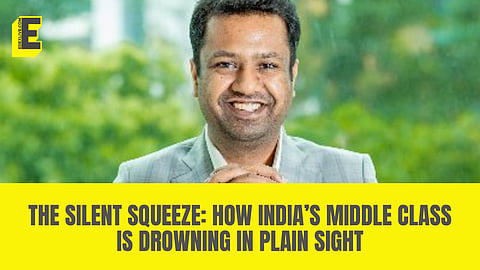

A provocative social media post by a Bengaluru CEO has reignited conversations about India's middle-class financial crisis, according to a recent report by The Economic Times. The viral commentary has exposed the harsh reality facing millions of Indian families caught between stagnant incomes and spiralling expenses.
Ashish Singhal, CEO of PeepalCo, delivered a stark wake-up call through his LinkedIn post, branding middle-class salaries as "the biggest scam no one talks about." His data-driven analysis revealed a troubling pattern: while households earning under Rs 5 lakh annually saw modest 4% growth over the past decade, those in the Rs 5 lakh to Rs 1 crore bracket experienced a meagre 0.4% compound annual growth rate. Meanwhile, food prices surged nearly 80%, effectively halving purchasing power.
What makes this crisis particularly insidious is its invisible nature. Unlike dramatic economic collapses, this is what Singhal terms a "well-dressed decline." Middle-class families maintain appearances of prosperity, they still vacation annually, upgrade smartphones, and service EMIs, but the foundation beneath is crumbling.
The reality behind closed doors tells a different story. Families skip building savings, postpone medical visits, and perform mental calculations at every purchase. Credit cards and loans have become lifelines, masking the erosion of financial security with borrowed consumption.
"This isn't a collapse. It's a well-dressed decline," Singhal observed, capturing the essence of how millions live paycheck to paycheck while maintaining middle-class facades.
The middle class finds itself in a uniquely vulnerable position within India's economic ecosystem. While government welfare programmes support lower-income groups and the wealthy leverage investments for growth, middle-income earners face the double burden of rising costs without proportional support systems.
Essential expenses across food, education, healthcare, and fuel have outpaced salary growth, creating a widening gap that credit is desperately trying to fill. The result is a generation of families living beyond their means, not by choice, but by necessity.
Singhal's observation resonates deeply: "The poor are being supported. The rich are scaling. The middle class is just expected to absorb the shock, in silence. No complaints. No bailouts. Just inflation, EMIs, and quiet pressure."
The LinkedIn post sparked intense online debate, revealing the widespread nature of middle-class anxiety. Responses ranged from shared frustration to calls for self-reflection and systemic change.
One entrepreneur challenged the narrative of passive victimhood, commenting that "the middle class is quietly getting squeezed from both sides. But it's also its own fault for choosing to stay quiet and naively hoping that just staying the course of 9 to 9 jobs, home loans and car loans will improve the situation."
Others turned the spotlight on corporate leadership, with one CEO questioning Singhal's own compensation practices relative to employee raises. The exchange highlighted the complex responsibility matrix surrounding wage stagnation.
Some voices expressed resignation, suggesting that "crying on any platform won't make any difference," while others shared personal success stories that countered the broader narrative. Yet the overwhelming response reflected deep-seated unease about economic security.
This isn't an isolated observation. Investment banker Kanishk Kar recently shared similar warnings, emphasising that "incomes haven't kept up with inflation" and describing middle-class Indians as "running on a treadmill that's speeding up while their shoes are wearing out."
Kar's assessment cuts to the heart of the issue: "The Indian middle class is not lazy. Not entitled. Not unambitious. They're just running on a treadmill that's speeding up while their shoes are wearing out."
India's middle class represents 31% of the population as of 2021, with projections suggesting growth to 38% by 2031 and 60% by 2047. However, this numerical expansion masks declining financial health within the demographic.
The expansion appears driven more by population shifts than genuine economic improvement. As more households technically enter middle-class income brackets, many find themselves struggling to maintain the lifestyle expectations that traditionally accompany that status.
The current middle-class experience is characterised by lifestyle maintenance funded through debt rather than income growth. Families continue aspirational spending patterns — vacations, gadgets, dining out — but increasingly rely on credit to bridge the gap between earnings and expenses.
This debt-funded consumption creates an illusion of prosperity while building long-term financial vulnerability. Emergency funds shrink, insurance coverage remains inadequate, and health expenses get deferred, creating a precarious foundation for millions of households.
As India's economy continues its growth trajectory, the middle class — traditionally viewed as the engine of consumption and stability — faces an unprecedented squeeze. Without systemic interventions addressing wage stagnation, inflation management, or targeted support mechanisms, this demographic risks becoming economically hollowed out despite maintaining surface-level prosperity.
The viral nature of Singhal's post suggests widespread recognition of this crisis, but meaningful solutions remain elusive. As India positions itself as a global economic power, the financial health of its middle class may prove to be the ultimate test of sustainable, inclusive growth.
The question remains whether policymakers and business leaders will address this "well-dressed decline" before it undermines the very foundation of India's consumer economy.
